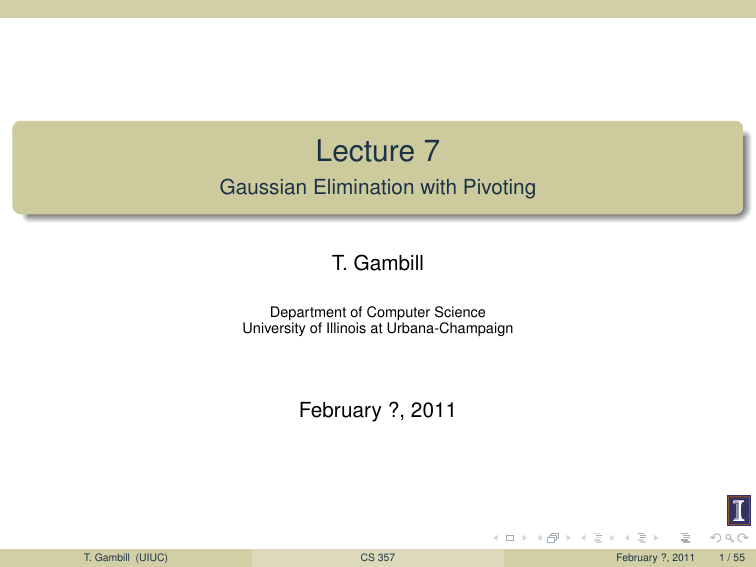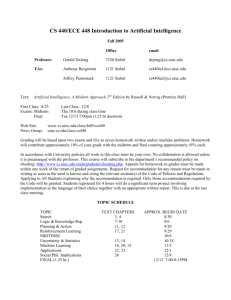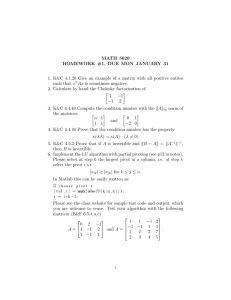
Lecture 7 Gaussian Elimination with Pivoting T. Gambill Department of Computer Science University of Illinois at Urbana-Champaign February ?, 2011 T. Gambill (UIUC) CS 357 February ?, 2011 1 / 55 Naive Gaussian Elimination Algorithm Forward Elimination + Backward substitution = Naive Gaussian Elimination T. Gambill (UIUC) CS 357 February ?, 2011 2 / 55 Goals for today. . . Identify why our basic GE method is “naive”: identify where the errors come from? I division by zero, near-zero Propose strategies to eliminate the errors I partial pivoting, complete pivoting, scaled partial pivoting Investigate the cost: does pivoting cost too much? Try to answer “How accurately can we solve a system with or without pivoting?” I Analysis tools: norms, condition number, . . . T. Gambill (UIUC) CS 357 February ?, 2011 3 / 55 Why is our basic GE “naive”? Example 0 A = 4 7 2 5 8 3 6 9 Example 1e − 10 A= 4 7 T. Gambill (UIUC) CS 357 2 3 5 6 8 9 February ?, 2011 4 / 55 The Need for Pivoting Solve: 2 1 A= −3 −1 4 2 −3 1 −2 −2 4 −3 8 −2 6 −3 −4 5 b= 7 7 Note that there is nothing ”wrong” with this system. A is full rank. The solution exists and is unique. Form the augmented system. 2 4 −2 −2 −4 1 2 4 −3 5 −3 −3 8 −2 7 −1 1 6 −3 7 T. Gambill (UIUC) CS 357 February ?, 2011 5 / 55 The Need for Pivoting Subtract 1/2 times the first row from the second row, add 3/2 times the first row to the third row, add 1/2 times the first row to the fourth row. The result of these operations is: 2 4 −2 −2 −4 0 0 5 −2 7 0 3 5 −5 1 0 3 5 −4 5 The next stage of Gaussian elimination will not work because there is a zero in the pivot location, ã22 . T. Gambill (UIUC) CS 357 February ?, 2011 6 / 55 The Need for Pivoting Swap second and fourth rows of the augmented matrix. 2 4 −2 −2 −4 0 3 5 −4 5 0 3 5 −5 1 0 0 5 −2 7 Continue with elimination: subtract (1 times) row 2 from row 3. 2 4 −2 −2 −4 0 3 5 −4 5 0 0 0 −1 −4 0 0 5 −2 7 T. Gambill (UIUC) CS 357 February ?, 2011 7 / 55 The Need for Pivoting Another zero has appear in the pivot position. Swap row 3 and row 4. 2 4 −2 −2 −4 0 3 5 −4 5 0 0 5 −2 7 0 0 0 −1 −4 The augmented system is now ready for backward substitution. T. Gambill (UIUC) CS 357 February ?, 2011 8 / 55 another example ε 1 1 x1 1 = 1 x2 2 Example With Naive GE, ε 0 1 (1 − ε1 ) 1 x1 = x2 2 − ε1 Solving for x1 and x2 using exact arithmetic we get 2 − 1/ε ε =1+ ≈1−ε 1 − 1/ε ε−1 1 − x2 −1 ε x1 = = =1− ≈1+ε ε ε−1 ε−1 x2 = However using finite precision floating point arithmetic for ε ≈ 10−20 , x1 ≈ 0, x2 ≈ 1. —Why? T. Gambill (UIUC) CS 357 February ?, 2011 9 / 55 Pivoting Strategies Partial Pivoting: Exchange only rows Exchanging rows does not affect the order of the xi For increased numerical stability, make sure the largest possible pivot element is used. This requires searching in the partial column below the pivot element. Partial pivoting is usually sufficient. T. Gambill (UIUC) CS 357 February ?, 2011 10 / 55 Partial Pivoting To avoid division by zero, swap the row having the zero pivot with one of the rows below it. Rows completed in forward elimination. Row with zero pivot element 0 Rows to search for a more favorable pivot element. * To minimize the effect of roundoff, always choose the row that puts the largest pivot element on the diagonal, i.e., find ip such that |aip ,i | = max(|ak,i |) for k = i, . . . , n T. Gambill (UIUC) CS 357 February ?, 2011 11 / 55 Partial Pivoting Pivoting (that is row exchanges) can be expressed in terms of matrix multiplication Do pivoting during elimination, but track row exchanges in order to express pivoting with matrix P Let P be all zeros I I I Place a 1 in column j of row 1 to exchange row 1 and row j If no row exchanged needed, place a 1 in column 1 of row 1 Repeat for all rows of P P is a permutation matrix Now using pivoting, LU = PA T. Gambill (UIUC) CS 357 February ?, 2011 12 / 55 Partial Pivoting Example 2 1 A= −3 −1 4 2 −3 1 −2 −2 4 −3 8 −2 6 −3 −4 5 b= 7 7 Apply the elementary permutation matrix P1 to permute the first and third rows of A. 0 0 P1 ∗ A = 1 0 0 1 0 0 1 0 0 0 0 2 1 0 ∗ 0 −3 1 −1 4 2 −3 1 −2 4 8 6 −2 −3 1 −3 = −2 2 −3 −1 −3 8 2 4 4 −2 1 6 −2 −3 −2 −3 so we have, P1 ∗ A ∗ x = P1 ∗ b T. Gambill (UIUC) CS 357 February ?, 2011 13 / 55 Partial Pivoting Example Next apply M1 an elementary elimination matrix to the previous result, 1 0 0 0 −3 −3 8 −2 1/3 1 0 0 1 2 4 −3 M1 ∗ P1 ∗ A = 2/3 0 1 0 ∗ 2 4 −2 −2 −1/3 0 0 1 −1 1 6 −3 −3 0 = 0 0 −3 8 1 20/3 2 10/3 2 10/3 −2 −11/3 −10/3 −7/3 so we have, M1 ∗ P1 ∗ A ∗ x = M1 ∗ P1 ∗ b T. Gambill (UIUC) CS 357 February ?, 2011 14 / 55 Partial Pivoting Example Apply the elementary permutation matrix P2 to permute the second and third rows. 1 0 0 0 −3 −3 8 −2 0 0 1 0 0 1 20/3 −11/3 P2 ∗ M1 ∗ P1 ∗ A = 0 1 0 0∗ 0 2 10/3 −10/3 0 0 0 1 0 2 10/3 −7/3 −3 0 = 0 0 −3 2 1 2 8 10/3 20/3 10/3 −2 −10/3 −11/3 −7/3 so we have, P2 ∗ M1 ∗ P1 ∗ A ∗ x = P2 ∗ M1 ∗ P1 ∗ b T. Gambill (UIUC) CS 357 February ?, 2011 15 / 55 Partial Pivoting Example Next apply M2 an elementary elimination matrix to the previous result, 1 0 0 0 −3 −3 8 −2 0 1 0 0 2 10/3 −10/3 ∗ 0 M2 ∗ P2 ∗ M1 ∗ P1 ∗ A = 0 −1/2 1 0 0 1 20/3 −11/3 0 −1 0 1 0 2 10/3 −7/3 −3 0 = 0 0 −3 8 2 10/3 0 5 0 0 −2 −10/3 =U −2 1 so we have, M2 ∗ P2 ∗ M1 ∗ P1 ∗ A ∗ x = M2 ∗ P2 ∗ M1 ∗ P1 ∗ b and in this example there is no need to apply P3 then M3 . T. Gambill (UIUC) CS 357 February ?, 2011 16 / 55 Partial Pivoting Example Note that we can formally write, (M2 ∗ P2 ∗ M1 ∗ P1 ) ∗ A = U or −1 −1 −1 ∗ U = L0 ∗ U A = P−1 1 ∗ M1 ∗ P2 ∗ M2 −1 −1 −1 however the matrix L 0 = P−1 1 ∗ M1 ∗ P2 ∗ M2 is −2/3 −1 −1 −1 −1/3 L 0 = P−1 1 ∗ M1 ∗ P2 ∗ M2 = 1 1/3 1 0 0 1/2 1 0 0 0 0 1 0 1 and this is NOT lower triangular. T. Gambill (UIUC) CS 357 February ?, 2011 17 / 55 Partial Pivoting Example But we do note that this matrix L 0 is a permutation of a lower triangular matrix and specifically that for 1 0 0 0 0 0 1 0 0 0 1 0 0 0 1 0 0 1 0 0 1 0 0 0 P = P2 ∗ P1 = 0 1 0 0∗1 0 0 0=0 1 0 0 0 0 0 1 0 0 0 1 0 0 0 1 then P∗A T. Gambill (UIUC) (P ∗ L 0 ) ∗ U 0 0 1 1 0 0 = 0 1 0 0 0 0 1 0 −2/3 1 = −1/3 1/2 1/3 1 = 0 −2/3 −1/3 0 ∗ 0 1 1 1/3 0 0 0 0 ∗U 1 0 0 1 CS 357 1 0 0 1/2 1 0 ∗ U 0 0 0 1 0 1 February ?, 2011 18 / 55 Theorem LUP decomposition Any non-singular matrix A may be decomposed as L∗U =P∗A where P is a permutation matrix, L is unit lower triangular, and U is upper triangular. T. Gambill (UIUC) CS 357 February ?, 2011 19 / 55 MATLAB LUP Consider the Matlab solution to the problem just considered.We get Ax = b LU = PA 1 2 3 >> A = [ 2 4 -2 -2; 1 2 4 -3; -3 -3 8 -2; -1 1 6 -3]; >> b = [ -4;5;7;7]; >> [L,U,P] = lu(A) 4 5 L = 6 7 8 9 10 1.0000 -0.6667 -0.3333 0.3333 0 1.0000 0.5000 1.0000 0 0 1.0000 0.0000 0 0 0 1.0000 -3.0000 0 0 0 -3.0000 2.0000 0 0 8.0000 3.3333 5.0000 0 -2.0000 -3.3333 -2.0000 1.0000 11 12 U = 13 14 15 16 17 18 19 P = 20 21 22 23 24 0 1 0 0 0 0 1 0 1 0 0 0 0 0 0 1 25 26 27 28 29 30 31 >> x=U\(L\(P*b)) x = 1.0000 2.0000 3.0000 4.0000 T. Gambill (UIUC) CS 357 February ?, 2011 20 / 55 Partial Pivoting: Usually sufficient, but not always Partial pivoting is usually sufficient Consider 2 1 2c 1 2c 2 With Partial Pivoting, the first row is the pivot row: 2 2c 2c 0 1−c 2−c and for large c: 2 0 2c −c 2c −c so that x = 0 and y = 1. (exact is x = y = 1 for finite precision floating point arithmetic) The pivot is selected as the largest in the column, but it should be the largest relative to the full submatrix. T. Gambill (UIUC) CS 357 February ?, 2011 21 / 55 More Pivoting Strategies Full (or Complete) Pivoting: Exchange both rows and columns Column exchange requires changing the order of the xi For increased numerical stability, make sure the largest possible pivot element is used. This requires searching in the pivot row, and in all rows below the pivot row, starting the pivot column. Full pivoting is less susceptible to roundoff, but the increase in stability comes at a cost of more complex programming (not a problem if you use a library routine) and an increase in work associated with searching and data movement. T. Gambill (UIUC) CS 357 February ?, 2011 22 / 55 Full Pivoting Rows completed in forward elimination. 0 Row with zero pivot element * Rows to search for a more favorable pivot element. * Columns to search for a more favorable pivot element. T. Gambill (UIUC) CS 357 February ?, 2011 23 / 55 Full Pivoting For the matrix (assuming |c| >> 1), 2 1 2c 1 2c 2 swap the first and second columns to obtain, 2c 2 2c 1 1 2 and now apply GE, 2c 0 2 1− 2c 1 1 c and for large c: 2c 2 0 1 2c 1 so that x = 1 and y = 1. (exact is x = y = 1) T. Gambill (UIUC) CS 357 February ?, 2011 24 / 55 Theorem LU Decomposition Using Full Pivoting Any non-singular matrix A may be decomposed as L∗U =P∗A∗Q where P and Q are permutation matrices, L is unit lower triangular, and U is upper triangular. T. Gambill (UIUC) CS 357 February ?, 2011 25 / 55 Application of LU Decomposition — Matrix Inverse Given a nonsingular matrix A we can find A−1 by solving, A ∗ x = ei i = 1, . . . , n where the identity matrix In×n is written in column form as, I = [e1 |e2 | . . . |en ] This we are solving, Ax1 = e1 Ax2 = e2 .. . Axn = en and the inverse matrix is therefore (in column format), T. Gambill (UIUC) CS 357 February ?, 2011 26 / 55 Application of LU Decomposition — Matrix Inverse A−1 = [x1 |x2 | . . . xn ] Since LU factorization costs O( 23 n3 ) (assuming no pivoting) and for the n equations back-solving/forward-solving costs O( 34 n3 ) (see pp. 224-225 for details) thus the total cost is O(2n3 ). T. Gambill (UIUC) CS 357 February ?, 2011 27 / 55 Application of LU Decomposition — Determinant Given a matrix A we can perform a factorization, P∗A = L ∗ U thus det(P) ∗ det(A) = (−1)s ∗ det(A) = det(L) ∗ det(U) n Y 1∗ Ui,i i=1 where P is a permutation matrix and thus −1 if the number of elementary permutations is odd det(P) = +1 if the number of elementary permutations is even L is unit lower triangular and thus, det(L) = 1 and U is upper triangular so det(U) = the product of the diagonal elements of U T. Gambill (UIUC) CS 357 February ?, 2011 28 / 55 Application of LU Decomposition — Determinant Given a matrix A, 1 2 3 >> A = [ 2 1 1 0; 4 3 3 1; 8 7 9 5; 6 7 9 8]; >> [L,U,P] = lu(A) L = 4 5 6 7 8 9 1.0000 0.7500 0.5000 0.2500 0 1.0000 -0.2857 -0.4286 0 0 1.0000 0.3333 0 0 0 1.0000 8.0000 0 0 0 7.0000 1.7500 0 0 9.0000 2.2500 -0.8571 0 5.0000 4.2500 -0.2857 0.6667 U = 10 11 12 13 14 P = 15 0 0 0 1 >> det(A) ans = 8 16 17 18 19 20 21 0 0 1 0 1 0 0 0 0 1 0 0 where P is a permutation matrix and thus det(P) = −1(3 elementary permutations) L is unit lower triangular and thus, det(L) = 1 and U is upper triangular so det(U) = 8.0 ∗ 1.75 ∗ −0.8571 ∗ 0.6667 ≈ −8.0 T. Gambill (UIUC) CS 357 February ?, 2011 29 / 55 Geometric Interpretation of Singularity Consider a 2 × 2 system describing two lines that intersect y = −2x + 6 1 x+1 y= 2 The matrix form of this equation is 2 −1/2 1 1 x1 6 = x2 1 The equations for two parallel but not intersecting lines are 2 1 x1 6 = 2 1 x2 5 Here the coefficient matrix is singular (rank(A) = 1), and the system is inconsistent T. Gambill (UIUC) CS 357 February ?, 2011 30 / 55 Geometric Interpretation of Singularity The equations for two parallel and coincident lines are 2 1 x1 6 = 2 1 x2 6 The equations for two nearly parallel lines are 2 1 x1 6 = 2 + δ 1 x2 6+δ T. Gambill (UIUC) CS 357 February ?, 2011 31 / 55 Geometric Interpretation of Singularity 8 8 A and b are consistent A is nonsingular 6 4 4 2 2 0 0 0 1 2 3 A and b are inconsistent A is singular 6 4 0 8 1 2 3 4 8 A and b are consistent A is singular 6 4 4 2 2 0 0 0 T. Gambill (UIUC) 1 2 3 A and b are consistent A is ill conditioned 6 4 0 CS 357 1 2 3 4 February ?, 2011 32 / 55 Effect of Perturbations to b Consider the solution of a 2 × 2 system where 1 b= 2/3 One expects that the exact solutions to 1 Ax = and 2/3 Ax = 1 0.6667 will be different. Should these solutions be a lot different or a little different? T. Gambill (UIUC) CS 357 February ?, 2011 33 / 55 Norms Vectors: 1/p kxkp = |x1 |p + |x2 |p + . . . + |xn |p n X kxk1 = |x1 | + |x2 | + . . . + |xn | = |xi | i=1 kxk∞ = max (|x1 |, |x2 |, . . . , |xn |) = max (|xi |) i Matrices: kAxk = max kAuk kxk kuk=1 kAxkp kAkp = max x,0 kxkp m X kAk1 = max |aij | kAk = max x,0 16j6n kAk∞ = max 16i6m T. Gambill (UIUC) i=1 n X |aij | j=1 CS 357 February ?, 2011 34 / 55 Properties of Vector Norms Every vector norm must satisfy the following properties. kxk > 0 for x , 0 (where 0 is the zero vector) kαxk = |α|kxk for any scalar α ∈ R kx + yk 6 kxk + kyk triangle inequality The vector norm kxkp for p > 1, defined on the previous slide, satisfy the following properties. kxkq 6 kxkp for 1 6 p 6 q 6 +∞ and √ nkxk2 √ kxk2 6 nkxk∞ kxk1 6 kxk1 6 nkxk∞ T. Gambill (UIUC) CS 357 February ?, 2011 35 / 55 Properties of Matrix Norms Every matrix norm must satisfy the following properties. kAk > 0 for A , 0 (where 0 is the zero matrix) kαAk = |α|kAk for any scalar α ∈ R kA + Bk 6 kAk + kBk triangle inequality A Matrix norm created from a vector norm by the formula, kAk = max x,0 kAxk kxk is called an induced matrix norm. Induced matrix norms satisfy the following properties. kAxk 6 kAkkxk kABk 6 kAkkBk kIk = 1 where I is the identity matrix T. Gambill (UIUC) CS 357 February ?, 2011 36 / 55 Effect of Perturbations to b Perturb b with δb such that k(b + δb) − bk kδbk = 1, kbk kbk The perturbed system is A(x + δxb ) = b + δb Analysis shows (see next two slides for proof) that kδxb k kδbk 6 kAkkA−1 k kxk kbk (1) Thus, the effect of the perturbation is small only if kAkkA−1 k is small. kδxb k 1 kxk T. Gambill (UIUC) only if CS 357 kAkkA−1 k ∼ 1 February ?, 2011 37 / 55 Effect of Perturbations to b (Proof) Let x + δxb be the exact solution to the perturbed system A(x + δxb ) = b + δb (2) Expand Ax + Aδxb = b + δb Subtract Ax from left side and b from right side since Ax = b Aδxb = δb Left multiply by A−1 δxb = A−1 δb T. Gambill (UIUC) CS 357 (3) February ?, 2011 38 / 55 Effect of Perturbations to b (Proof, p. 2) Take norm of equation (3) kδxb k = kA−1 δbk Applying consistency requirement of matrix norms kδxb k 6 kA−1 kkδbk (4) Similarly, Ax = b gives kbk = kAxk, and kbk 6 kAkkxk (5) Rearrangement of equation (5) yields kAk 1 6 kxk kbk T. Gambill (UIUC) CS 357 (6) February ?, 2011 39 / 55 Effect of Perturbations to b (Proof) Multiply Equation (5) by Equation (4) to get kδbk kδxb k 6 kAkkA−1 k kxk kbk (7) Summary: If x + δxb is the exact solution to the perturbed system A(x + δxb ) = b + δb then T. Gambill (UIUC) kδxb k kδbk 6 kAkkA−1 k kxk kbk CS 357 February ?, 2011 40 / 55 Condition Number of Matrix Definition The condition number of a matrix A is defined by κ(A) = ||A|| ∗ ||A−1 || Remember our definition of condition number of a problem from lecture 3, how is this related? Relative Condition Number in higher dimensions Given a function G : Rn → Rn ,suppose we wish to compute y = G(x). How sensitive is the solution to changes in x? We can measure this sensitivity by: Relative Condition Number = lim||h||→0 ||G(x+h)−G(x)|| ||G(x)|| ||h|| ||x|| The Taylor Series for G is, G(x + h) = G(x) + G 0 (x) ∗ h + ... where G 0 (x) is the Jacobian. Thus, we get, T. Gambill (UIUC) CS 357 February ?, 2011 41 / 55 Condition Number of Matrix ||G 0 (x)|| ||x|| ||G(x + h) − G(x)|| ||x|| = ||h|| ||G(x)|| ||G(x)|| ||h||→0 Relative Condition Number = lim Our problem is to compute x = A−1 ∗ b (G is A−1 , x in G(x) is b and the y in y = G(x) is x in this analysis). Since the Jacobian of G(x) = A−1 b is A−1 we can substitute into the above formula to get, Relative Condition Number = ||A−1 || ||b|| ||x|| But we have ||Ax|| 6 ||A|| ||x|| or ||b|| 6 ||A|| ||x|| and after substitution we have, Relative Condition Number = T. Gambill (UIUC) ||A−1 || ||b|| 6 ||A−1 || ||A|| = κ(A) ||x|| CS 357 February ?, 2011 42 / 55 Effect of Perturbations to A Perturb A with δA such that k(A + δA) − Ak kδAk = 1, kAk kAk The perturbed system is (A + δA)(x + δxA ) = b Analysis shows that kδAk kδxA k 6 kAkkA−1 k kx + δxA k kAk Thus, the effect of the perturbation is small only if kAkkA−1 k is small. kδxA k 1 kx + δxA k T. Gambill (UIUC) only if CS 357 kAkkA−1 k ∼ 1 February ?, 2011 43 / 55 Effect of Perturbations to both A and b Perturb both A with δA and b with δb such that kδAk 1 kAk and kδbk 1 kbk The perturbation satisfies (A + δA)(x + δx) = b + δb Analysis shows that kδxk 6 kxk kAkkA−1 k 1 − kAkkA−1 k kδAk kAk kδAk kδbk + kAk kbk Thus, the effect of the perturbation is small only if kAkkA−1 k is small. kδxk 1 kx + δxk T. Gambill (UIUC) only if CS 357 kAkkA−1 k ∼ 1 February ?, 2011 44 / 55 Condition number of A The condition number κ(A) ≡ kAkkA−1 k indicates the sensitivity of the solution to perturbations in A and b. The condition number can be measured with any p-norm. The condition number is always in the range 1 6 κ(A) 6 ∞ κ(A) is a mathematical property of A Any algorithm will produce a solution that is sensitive to perturbations in A and b if κ(A) is large. In exact math a matrix is either singular or non-singular. κ(A) = ∞ for a singular matrix κ(A) indicates how close A is to being numerically singular. A matrix with large κ is said to be ill-conditioned T. Gambill (UIUC) CS 357 February ?, 2011 45 / 55 Condition number of A Geometric view Note that if we denote y = A−1 x so that Ay = x we can write, kA−1 xk x,0 kxk kyk = max y,0 kAyk 1 = max kAyk kA−1 k = max y,0 kyk 1 = miny,0 so κ(A) = kAyk kyk kAxk kxk kAyk miny,0 kyk maxx,0 and thus the condition number κ measures the ratio of the largest stretching to smallest stretching of any non-zero vector by the matrix. T. Gambill (UIUC) CS 357 February ?, 2011 46 / 55 The Residual Let x̂ be the numerical solution to Ax = b. x̂ , x (x is the exact solution) because of roundoff. The residual measures how close x̂ is to satisfying the original equation r = b − Ax̂ It is not hard to show from equation (1) that krk kx̂ − xk 6 κ(A) kxk kbk Small krk does not guarantee a small kx̂ − xk. If κ(A) is large the x̂ returned by Gaussian elimination and back substitution (or any other solution method) is not guaranteed to be anywhere near the true solution to Ax = b. T. Gambill (UIUC) CS 357 February ?, 2011 47 / 55 Computational Stability In Practice, applying Gaussian elimination with partial pivoting and back substitution to Ax = b gives the exact solution, x̂, to the nearby problem(see INC p. 239) εm kAk∞ (A + δA)x̂ = b where kδAk∞ . 2 Gaussian elimination with partial pivoting and back substitution “gives exactly the right answer to nearly the right question.” — Trefethen and Bau T. Gambill (UIUC) CS 357 February ?, 2011 48 / 55 Computational Stability An algorithm that gives the exact answer to a problem that is near to the original problem is said to be backward stable. Algorithms that are not backward stable will tend to amplify roundoff errors present in the original data. As a result, the solution produced by an algorithm that is not backward stable will not necessarily be the solution to a problem that is close to the original problem. Gaussian elimination without partial pivoting is not backward stable for arbitrary A. If A is symmetric and positive definite, then Gaussian elimination without pivoting in backward stable. T. Gambill (UIUC) CS 357 February ?, 2011 49 / 55 For a fixed vector b and for different matrices A the exact solution of Ax = b can be written as x = A−1 b. With finite precision arithmetic the solution is x̂. The matrix A + δA produces the solution of (A + δA)x̂ = b with exact arithmetic. exact A - x = A−1 b @ @ @ A+δA T. Gambill (UIUC) @ @ exact @ R @ - x̂ = (A+δA)−1 b CS 357 February ?, 2011 50 / 55 Rules of Thumb From (A + δA)x̂ = b where kδAk∞ . εm kAk∞ 2 and the definition of the residual, r = b − Ax̂ we can derive the following approximation, εm ||x̂ − x||∞ . κ(A) ||x||∞ 2 Applying Gaussian elimination with partial pivoting and back substitution to Ax = b yields a numerical solution x̂ such that the residual vector r = b − Ax̂ is small even if the κ(A) is large. If A and b are stored to machine precision εm , the numerical solution to Ax = b by any variant of Gaussian elimination is correct to d digits where d = | log10 (εm )| − log10 (κ(A)) T. Gambill (UIUC) CS 357 February ?, 2011 51 / 55 Rules of Thumb d = | log10 (εm )| − log10 (κ(A)) Example: MATLAB computations have εm ≈ 2.2 × 10−16 . For a system with κ(A) ∼ 1010 the elements of the solution vector will have d = | log10 (2.2 × 10−16 )| − log10 1010 ≈ 16 − 10 ≈6 correct (decimal) digits T. Gambill (UIUC) CS 357 February ?, 2011 52 / 55 Summary of Limits to Numerical Solution of Ax = b 1 κ(A) indicates how close A is to being numerically singular 2 If κ(A) is “large”, A is ill-conditioned and even the best numerical algorithms will produce a solution, x̂ that cannot be guaranteed to be close to the true solution, x 3 In practice, Gaussian elimination with partial pivoting and back substitution produces a solution with a small residual r = b − Ax̂ even if κ(A) is large. T. Gambill (UIUC) CS 357 February ?, 2011 53 / 55 The Backslash Operator Consider the scalar equation 5x = 20 =⇒ x = (5)−1 20 The extension to a system of equations is, of course Ax = b =⇒ x = A−1 b where A−1 b is the formal solution to Ax = b In MATLAB notation the system is solved with 1 x = A\b T. Gambill (UIUC) CS 357 February ?, 2011 54 / 55 The Backslash Operator Given an n × n matrix A, and an n × 1 vector b the \ operator performs a sequence of tests on the A matrix. MATLAB attempts to solve the system with the method that gives the least roundoff and the fewest operations. When A is an n × n matrix: 1 MATLAB examines A to see if it is a permutation of a triangular system If so, the appropriate triangular solve is used. 2 MATLAB examines A to see if it appears to be symmetric and positive definite. If so, MATLAB attempts a Cholesky factorization and two triangular solves. 3 If the Cholesky factorization fails, or if A does not appear to be symmetric, MATLAB attempts an LU factorization and two triangular solves. T. Gambill (UIUC) CS 357 February ?, 2011 55 / 55





